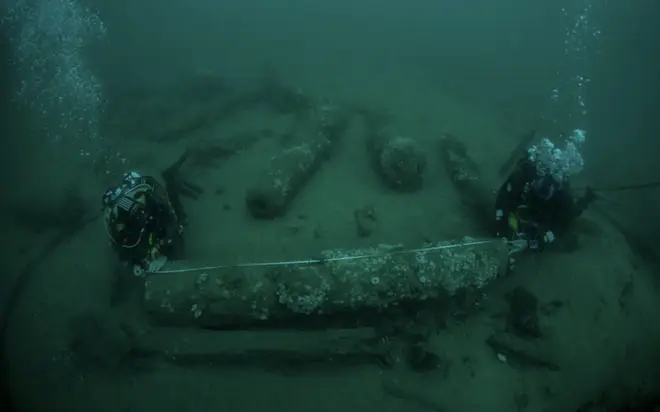
Tonight with Andrew Marr 6pm - 7pm
10 June 2022, 10:28

The wreck of a royal warship which sank in 1682 while carrying the future king James Stuart has been discovered off the coast of Norfolk after being kept a closely-guarded secret for 15 years.
The HMS Gloucester ran aground some 28 miles off Great Yarmouth following a dispute between James, then the Duke of York, and the ship's pilot James Ayres about navigating the treacherous Norfolk sandbanks.
It sank within an hour of the strike, at 5.30am on May 6, killing around 130 to 250 crew and passengers.
The wreck was found by brothers Julian and Lincoln Barnwell, together with others, following a four-year search over 5,000 nautical miles.
They found the site in 2007 but kept it secret for security reasons to protect the 'at risk' site, which lies in international waters. Extra time was taken to confirm the identity of the ship but it can now be made public.

After the ship sank, James barely survived, having delayed abandoning ship until the last minute and needlessly costing the lives of many who, because of protocol, could not abandon the ship before royalty.
He accepted no responsibility for the sinking, instead blaming the pilot and wishing him to be hanged immediately, though Mr Ayres was in fact court-martialled and imprisoned.
James went on to reign as King James II of England and Ireland and James VII of Scotland from 1685 until 1688, when he was deposed by the Glorious Revolution.
It has been described by a historian as the most important maritime discovery since the Mary Rose, the warship from the Tudor navy of King Henry VIII.
The Mary Rose sank in battle in the Solent in 1545, and was raised in 1982, later being put on display in Portsmouth.
Lincoln Barnwell said: "It was our fourth dive season looking for Gloucester.
Read more: Almost 10,000 buildings 'unsafe' with danger cladding five years on from Grenfell
"We were starting to believe that we were not going to find her, we'd dived so much and just found sand.
"On my descent to the seabed, the first thing I spotted were large cannon laying on white sand, it was awe-inspiring and really beautiful.
"It instantly felt like a privilege to be there, it was so exciting.
"We were the only people in the world at that moment in time who knew where the wreck lay. That was special and I'll never forget it.
"Our next job was to identify the site as the Gloucester."
Maritime history expert Prof Claire Jowitt, of the University of East Anglia (UEA), said: "Because of the circumstances of its sinking, this can be claimed as the single most significant historic maritime discovery since the raising of the Mary Rose in 1982.
"The discovery promises to fundamentally change understanding of 17th-century social, maritime and political history.
"It is an outstanding example of underwater cultural heritage of national and international importance.
"A tragedy of considerable proportions in terms of loss of life, both privileged and ordinary, the full story of the Gloucester's last voyage and the impact of its aftermath needs re-telling, including its cultural and political importance, and legacy.
"We will also try to establish who else died and tell their stories, as the identities of a fraction of the victims are currently known."
The Gloucester represents an important 'almost' moment in British political history: a royal shipwreck causing the very near-death of the Catholic heir to the Protestant throne at a time of great political and religious tension.
The ship was commissioned in 1652, built at Limehouse in London, and launched in 1654.
In 1682 it was selected to carry James to Edinburgh to collect his heavily pregnant wife and their households.
The aim was to bring them back to King Charles II's court in London in time, it was hoped, for the birth of a legitimate male heir.
The ship set sail from Portsmouth, with James and his entourage joining it off Margate in Kent, having travelled by yacht from London, before it ran aground off the Norfolk coast.
Diarist and naval administrator Samuel Pepys, who witnessed events from another ship in the fleet, wrote his own account - describing the harrowing experience for victims and survivors, with some picked up "half dead" from the water.
As well as James, HMS Gloucester carried a number of prominent English and Scottish courtiers including John Churchill, later the 1st Duke of Marlborough.
The Barnwell brothers found the wreck site in 2007, together with their late father Michael and two friends including James Little, a former Royal Navy submariner and diver.
The ship was split down the keel and the remains of the hull were submerged in the sand.
The ship's bell, manufactured in 1681, was later recovered, and in 2012 it was used by the Receiver of Wreck and Ministry of Defence to decisively identify the vessel as the HMS Gloucester.
As well as the Receiver of Wreck and Ministry of Defence, the wreck has been declared to Historic England.
Artefacts rescued and conserved from the wreck include clothes and shoes, navigational and other professional naval equipment, personal possessions, and many wine bottles.
One of the bottles bears a glass seal with the crest of the Legge family - ancestors of George Washington, the first US President.
The crest was a forerunner to the Stars and Stripes flag.
There were also some unopened bottles, with wine still inside -- offering opportunities for future research.
An exhibition is planned for Spring 2023 at Norwich Castle Museum and Art Gallery to display finds from the wreck and share ongoing historical, scientific and archaeological research.